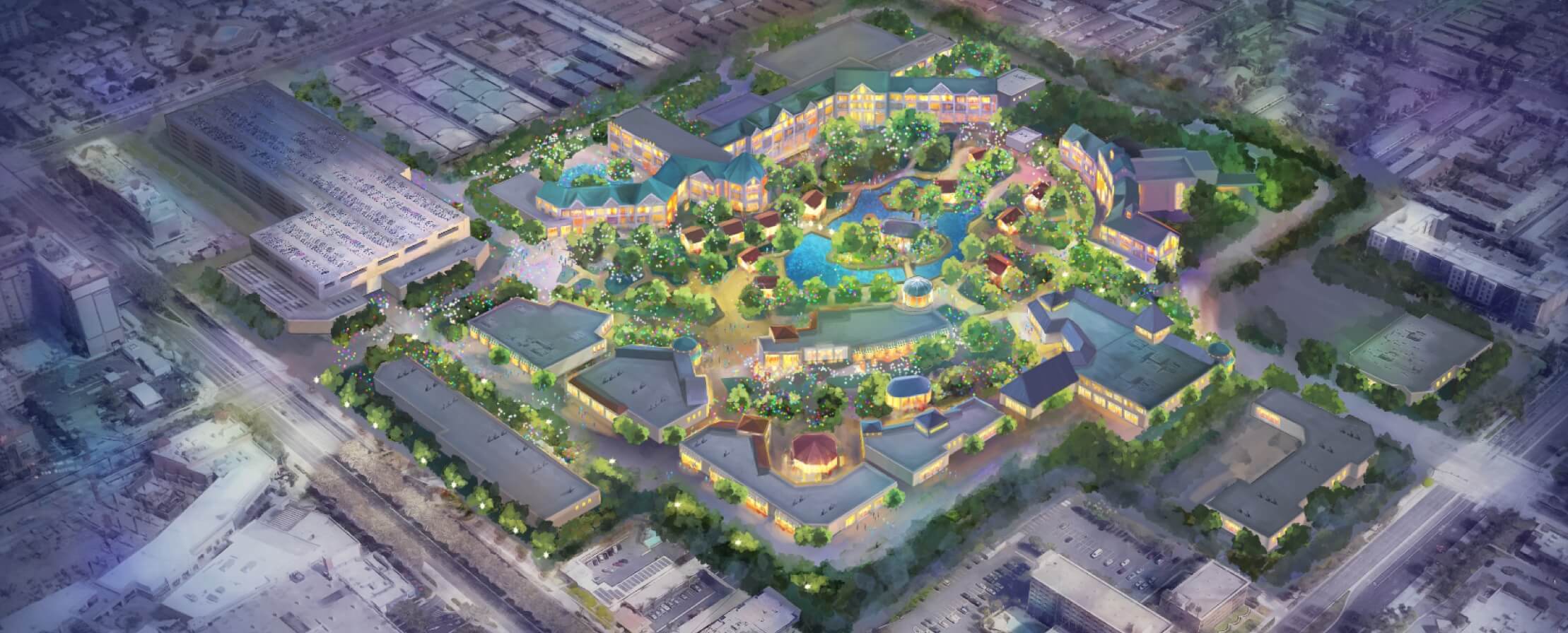

Disney and the City of Anaheim have released new details about DisneylandForward, specifically spending commitments over the course of the next decade at Disneyland Resort if the proposal for new theme park, retail, and parking expansion in California is approved. This quickly runs through the highlights of what Disney has promised as part of its 10-year plan.
For those who are unfamiliar with it, DisneylandForward is a conceptual development plan for Disney to work with Anaheim to grow the area, update the blueprint for the resort district, and facilitate the city’s economic rebound. DisneylandForward does not involve the company acquiring additional property–it stays within Disney’s existing 500-acre footprint in Anaheim with no physical expansion or additional acreage.
Critically, DisneylandForward also does not commit to building any specific new theme park lands or rides. You might see reference elsewhere to possible expansion based on Wakanda, Zootopia, Frozen, Fantasy Springs, Tangled, Peter Pan, Toy Story and TRON. These are merely blue sky examples that have been pulled from other parks around the world. In actuality, DisneylandForward is the company’s pitch to the public and City of Anaheim for more flexibility in the master plans from the 1990s in order to give the company greater autonomy over what to build and where.
Up until now, we’ve mostly heard about what Disney wants and why, with vague references to possibilities. Now that we’re in the home stretch of the DisneylandForward approval process, Disney has shared what it’s willing to give or commit to in order to get DisneylandForward approved. This is really the first time we’ve had anything concrete from the company about the proposal, so we thought it’d be worth sharing and discussing.
If you’re looking for background and commentary about the proposal, which remains accurate notwithstanding these new details, see our comprehensive look at the DisneylandForward Theme Park Expansion Proposal. That covers a detailed breakdown of what this proposal is and isn’t, and will bring you up to speed.
For this post, we’ll fast-forward to the details of the proposed DisneylandForward development agreement between the company and city that were released in January 2024 during an Anaheim City Council workshop.
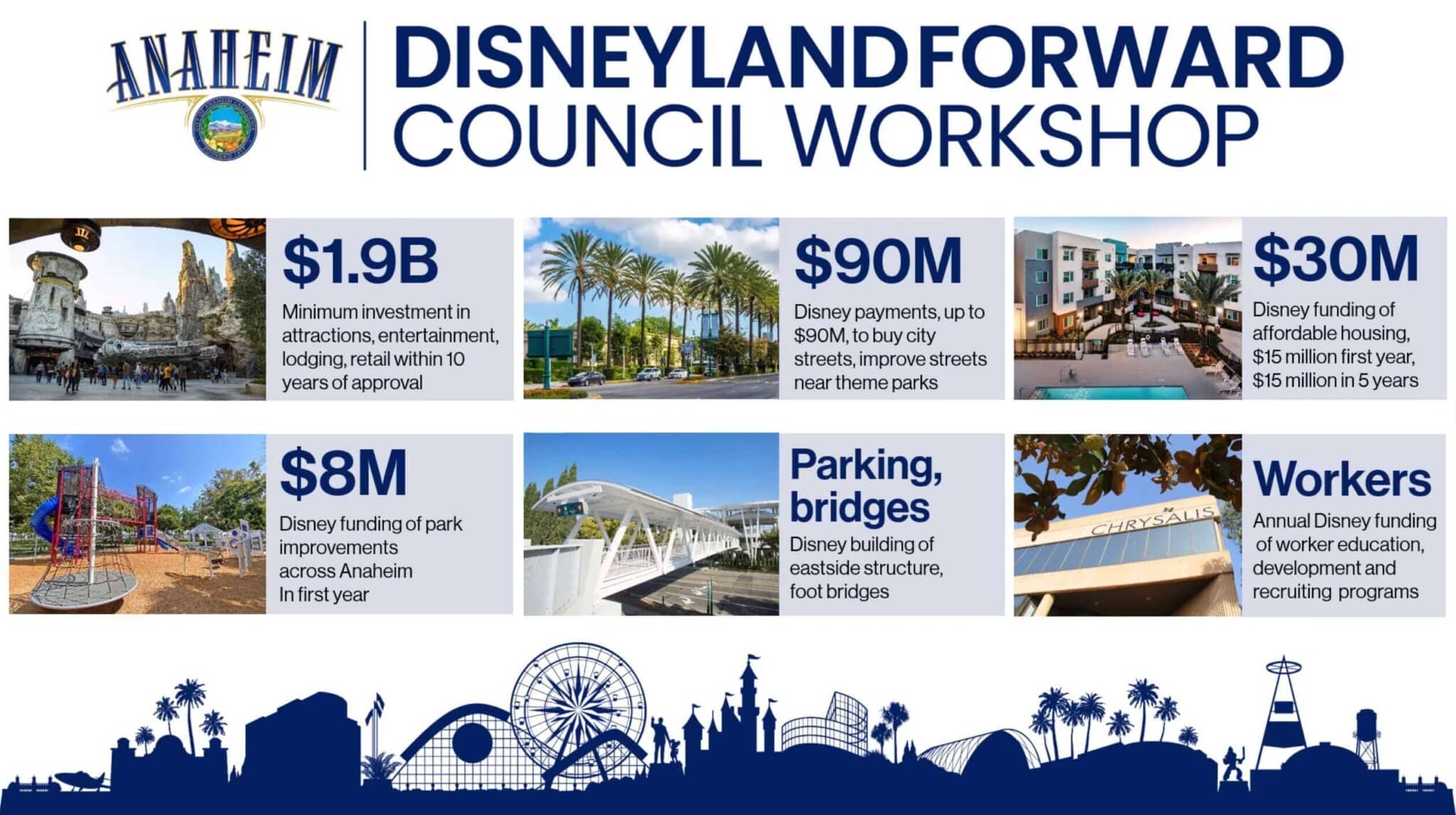

Let’s start with the juiciest portion of the proposed development agreement, which is the committed investment by Disney as part of DisneylandForward. If approved, the company would promise a minimum of $1.9 billion invested in Disneyland Resort over the next decade, with potential for up to $2.5 billion invested.
If investment doesn’t reach $2.5 billion in 10 years, Disney would pay an additional $5 million for street and transportation improvements. (Given that the penalty is peanuts and not enough to incentivize spending, I think calling this a ~$2 billion commitment is probably more apt. My bet is that Disney wants to invest the full $2.5 billion and has a plan to do so, but won’t follow through with the final $600 if the economic environment is unfavorable.)
Significantly, this multi-billion investment would go towards theme park attractions, entertainment, lodging, shopping and dining–including expansion west of Disneyland Drive and replacing the current Toy Story Parking Area. Specific themed lands, attractions, and other development have yet to be determined.
This minimum investment only covers visitor attractions and the above. It does not include investments in parking, road improvements, or bridges. This is important because Disney could easily spend a few hundred millions of dollars on infrastructure if DisneylandForward is approved. As discussed below, they have big plans on that front, and the company has been salivating at the prospects of reworking infrastructure since around 2017.
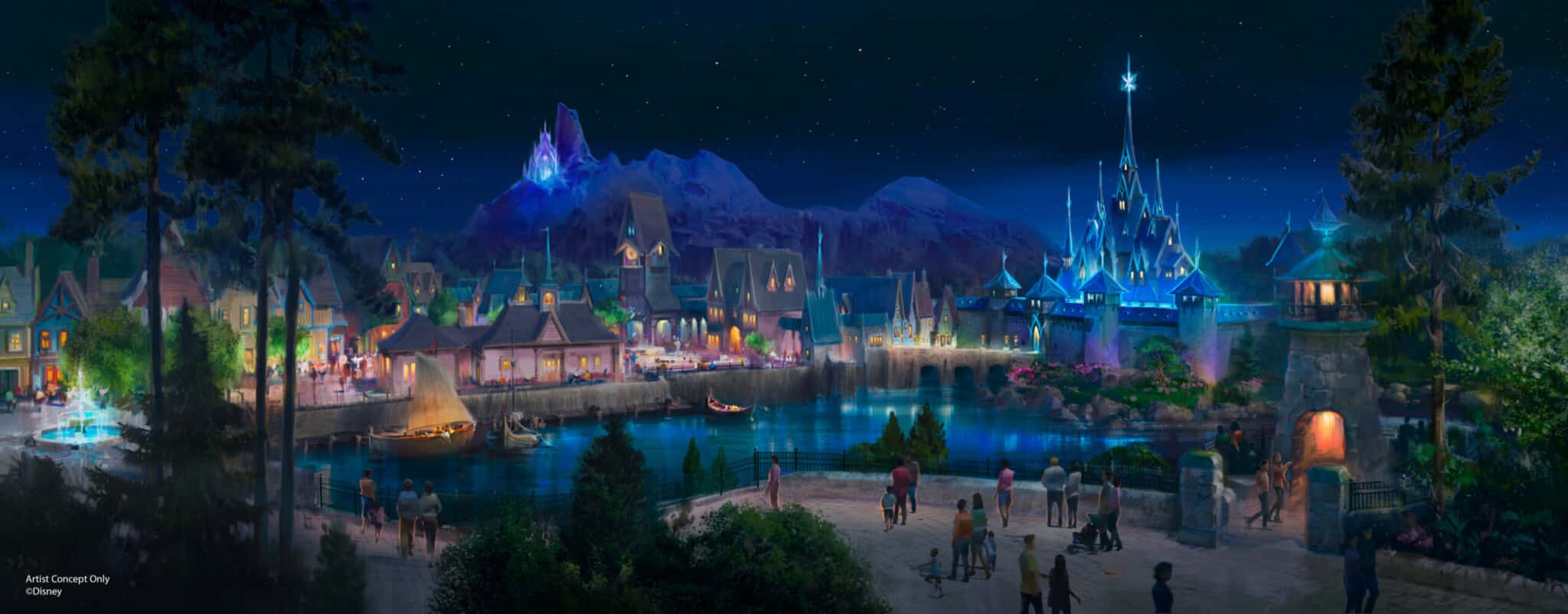

In terms of commentary, I’m mixed on this. Based on credible rumors of proposed projects in the existing gates (Disneyland and Disney California Adventure), Disney probably intends upon spending about $2 billion at Disneyland Resort in the next 10 years even in the absence of this proposal.
If anything, I think this is probably why the last D23 Expo and Destination D23 was light on announcements for Disneyland (even of the “non-announcement announcement” variety, like WDW has gotten). Disney was withholding its plans as a bargaining chip for DisneylandForward, wanting to force the city’s hand a bit and give residents more of a reason to support the proposal.
If you look back at the last decade (Star Wars Galaxy’s Edge), the one before that (Cars Land & DCA overhaul), or the one before that (original DCA construction), I think you’d find that ~$2 billion is about the norm for a decade of investment at Disneyland. So unless you assumed the company would otherwise slow its spending on the California parks, this $2 to $2.5 billion mostly represents the status quo.
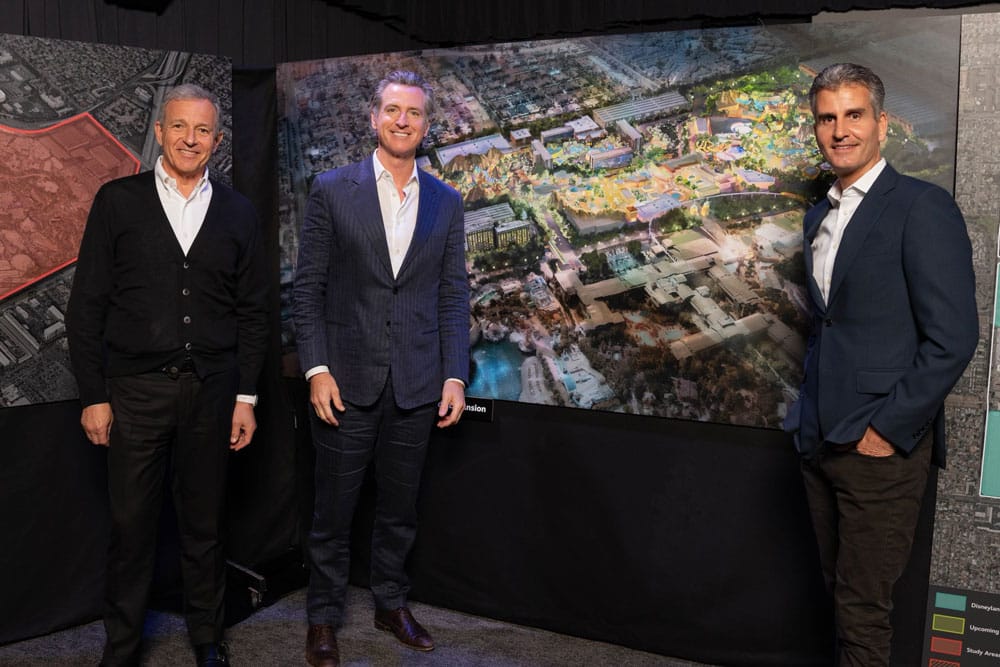

However, I also think it’s fair to say that maybe Disney would otherwise start to slow down on spending at Disneyland, especially after encountering so much resistance from the city on projects greenlit after Star Wars: Galaxy’s Edge. Without an updated master plan and more autonomy, maybe Disney determines it’s not worth it to investment billions of dollars per decade into Disneyland–too much uncertainty, friction, and potential for projects to fail prior to approval.
Locking in a minimum of $1.9 billion in spending outside of infrastructure plus other deal sweeteners (see below) in exchange for giving Disney more certainty strikes me as a win-win for the company and city. If I were Anaheim, I’d want to move as quickly as possible on this, as it’s a near-term “competitive” advantage while Florida and Disney are at-odds.
While I don’t think that’ll cause the company to reduce spending at Walt Disney World in the long run, it certainly could shift allocations in the near term–prioritizing projects in California. Which is probably precisely why Governor Newsom implicitly endorsed DisneylandForward.
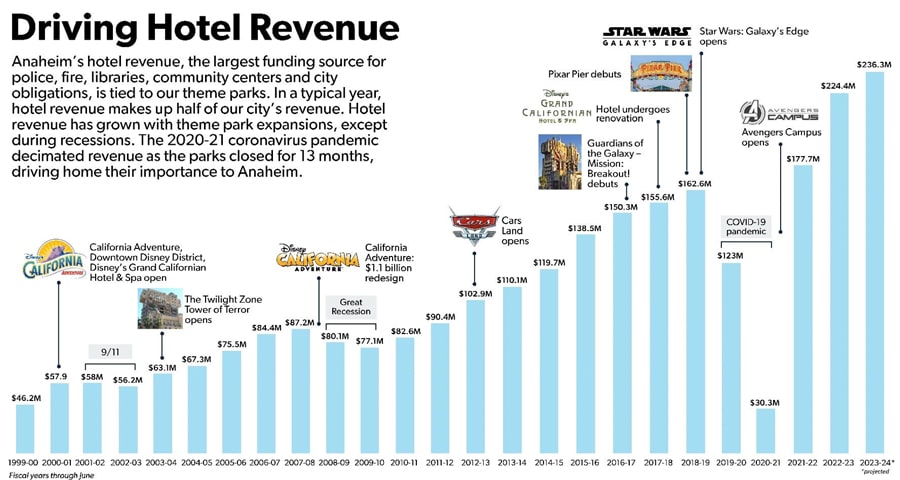

While I can appreciate checks and balances and involvement from local stakeholders, I also saw how that played out in 2016-2018. Area businesses, politicians and unions were able to kill Disneyland projects because they feared change or that they weren’t getting enough out of the deal. It ended up being detrimental to growth, and I think it’s probably fair to say that Anaheim as a whole would be better off had those projects happened.
There’s certainly an argument to be made for letting Disneyland have more autonomy to do its thing, as there’s already a direct incentive for the company to put the land it already owns to its highest and best use. That everyone in Anaheim, including third party businesses, benefits from a stronger and healthier Disneyland, especially if it continues evolving into a ‘destination’ resort. (Those businesses have already seen tremendous upside since Cars Land in 2012!)
Anaheim has probably missed out on $500 million or so of investments in Disneyland Resort as a result of past standoffs and the current holding pattern. Not only that, but approving this could certainly mean more than $2.5 billion in the next decade–it’s not like there’s a hard cap on spending. If future projects go smoothly and Disneyland is overperforming, there will be motivation to build more as expeditiously as possible. But admittedly, I’m biased as a Disney fan who wants to see more development at Disneyland.
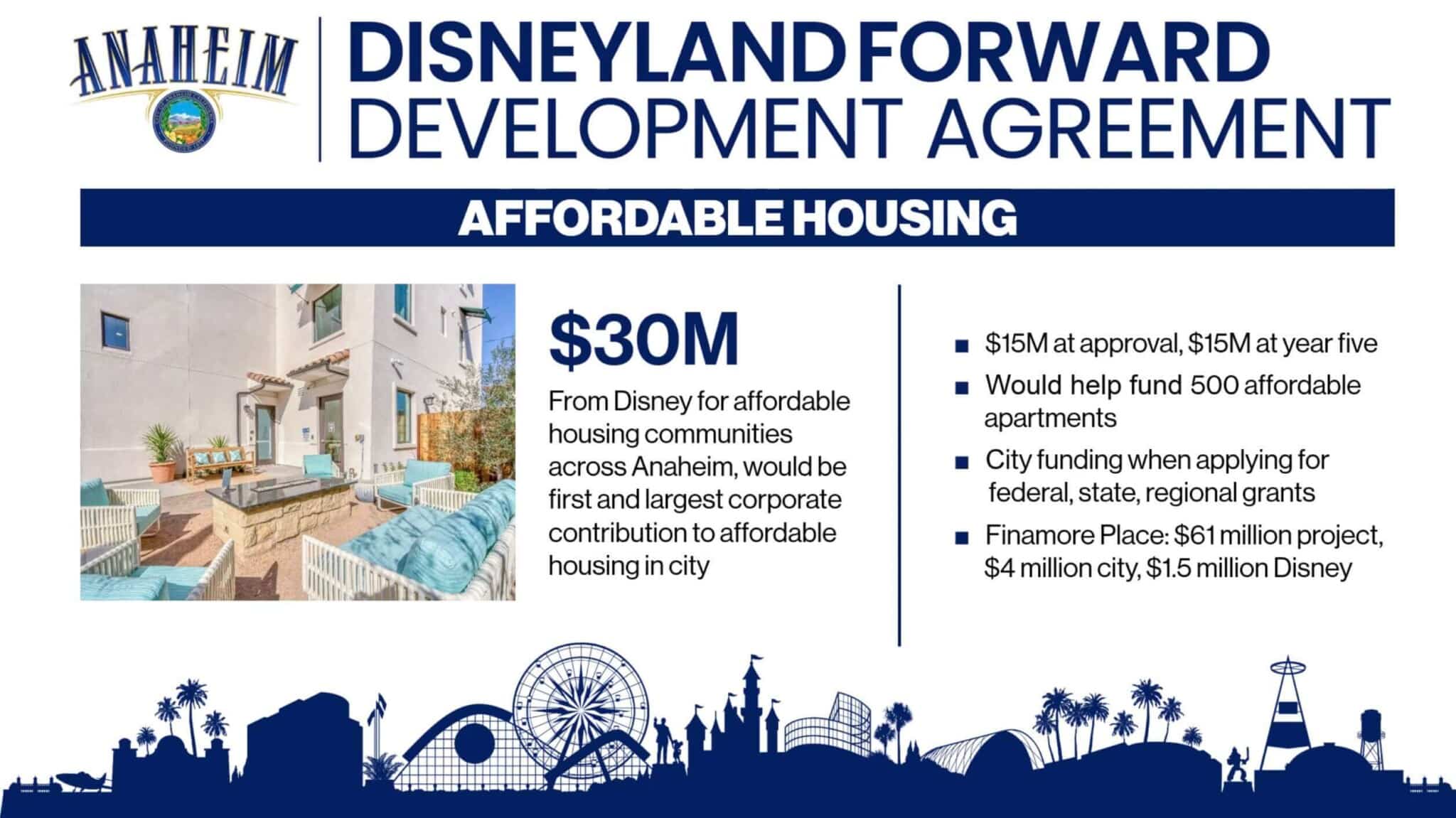

In addition, Disney commits to funding affordable housing in Anaheim as part of the DisneylandForward community benefits:
- Disney would pay $30 million for affordable housing across Anaheim, with $15 million coming in the first year and $15 million at five years
- This would be first and largest corporate contribution to Anaheim affordable housing
- The $30 million would be leveraged, and used with federal, state and regional funding to help develop about 500 affordable housing apartments citywide
- Disney’s cash would play critical role for federal, state and regional grants–Anaheim having more cash on hand makes it more competitive for these grants
- Anaheim currently contributes $6 million to $8 million in city development funding for affordable communities that can cost $50 million to $75 million
- Example: Finamore Place, a $61 million, 102-apartment community opened in 2023, included $4 million in city development funding and $1.5 million in Disney funding as part of $5 million given to the Orange County Housing Trust
Honestly, I don’t know how Disney and Anaheim get to 500 affordable housing units from the $30 million, but I assume it’s when paired with the grants, which essentially adds a multiplier factor. It would seem that Disney’s cash injection would serve as a catalyst for further funding. Definitely a good thing and no criticism from me on this.
What California really needs, though, is more housing reform to reduce barriers to actually building. Incremental progress has been made in the last couple of years, but not nearly enough. This is not a Disney or an Anaheim problem, it’s everywhere. That’s beyond the scope of this post, but the point is that it’s absurd to view this as a problem that’s solvable by Disney.
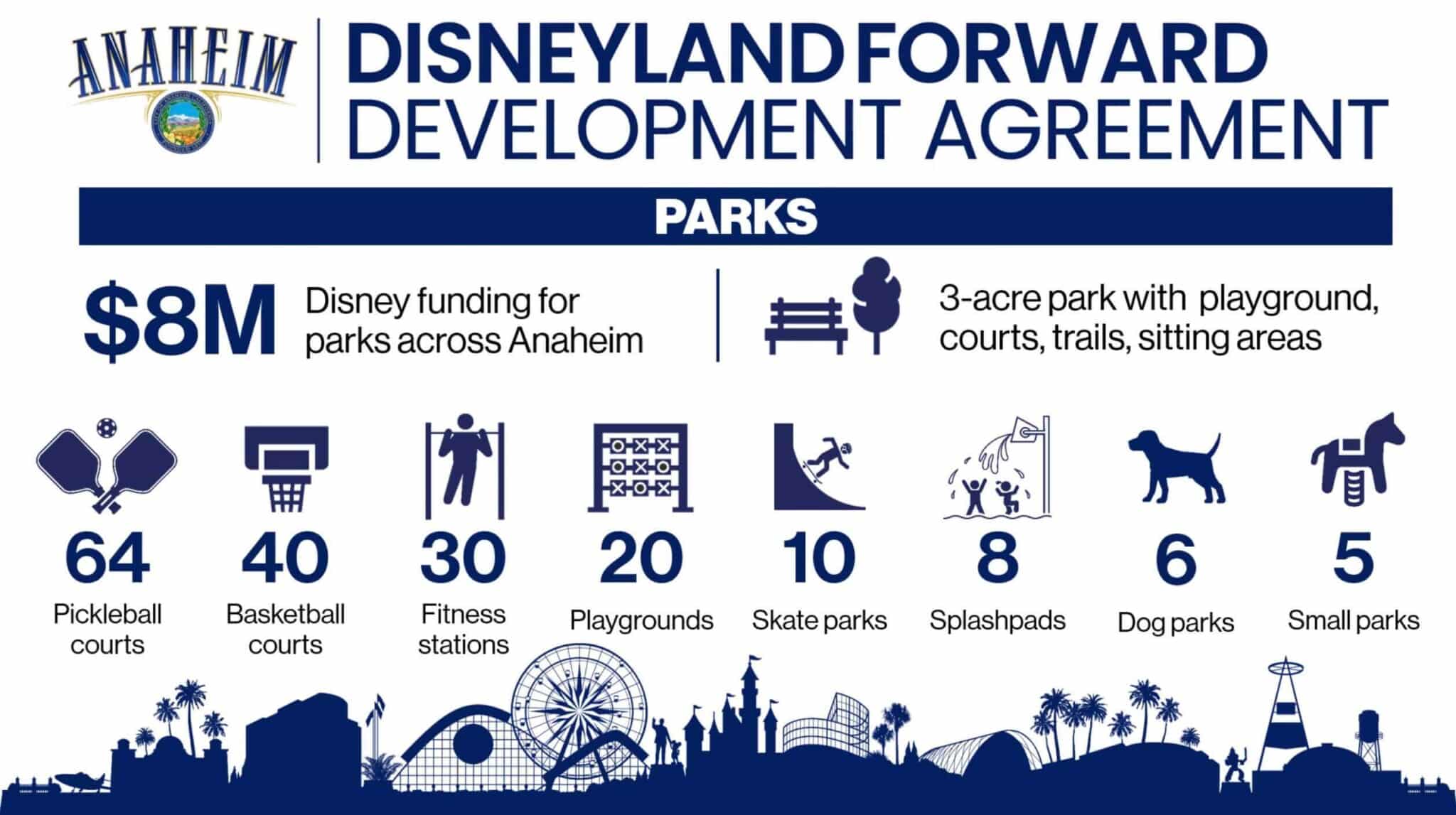

Disney would also fund Anaheim public parks as part of DisneylandForward community benefits:
- Disney commits $8 million for Anaheim parks at approval, and the city determines how funding would be used
- $8 million could fund a 3-acre park with a playground, sports court, walking trails, sitting areas
- $8 million could fund upgrades across the city, including a mix of: 64 pickleball courts, 40 basketball courts, 30 fitness stations with exercise equipment, 20 playgrounds, 10 skate parks, 8 water play areas, 6 dog parks, or 5 smaller pocket parks
I doubt anyone reading this really cares about public parks in Anaheim. The only commentary I’ll add here is that Orange County has some fantastic public spaces south of Anaheim that greatly improve livability. Bringing those types of parks to Anaheim would be a huge win for residents.
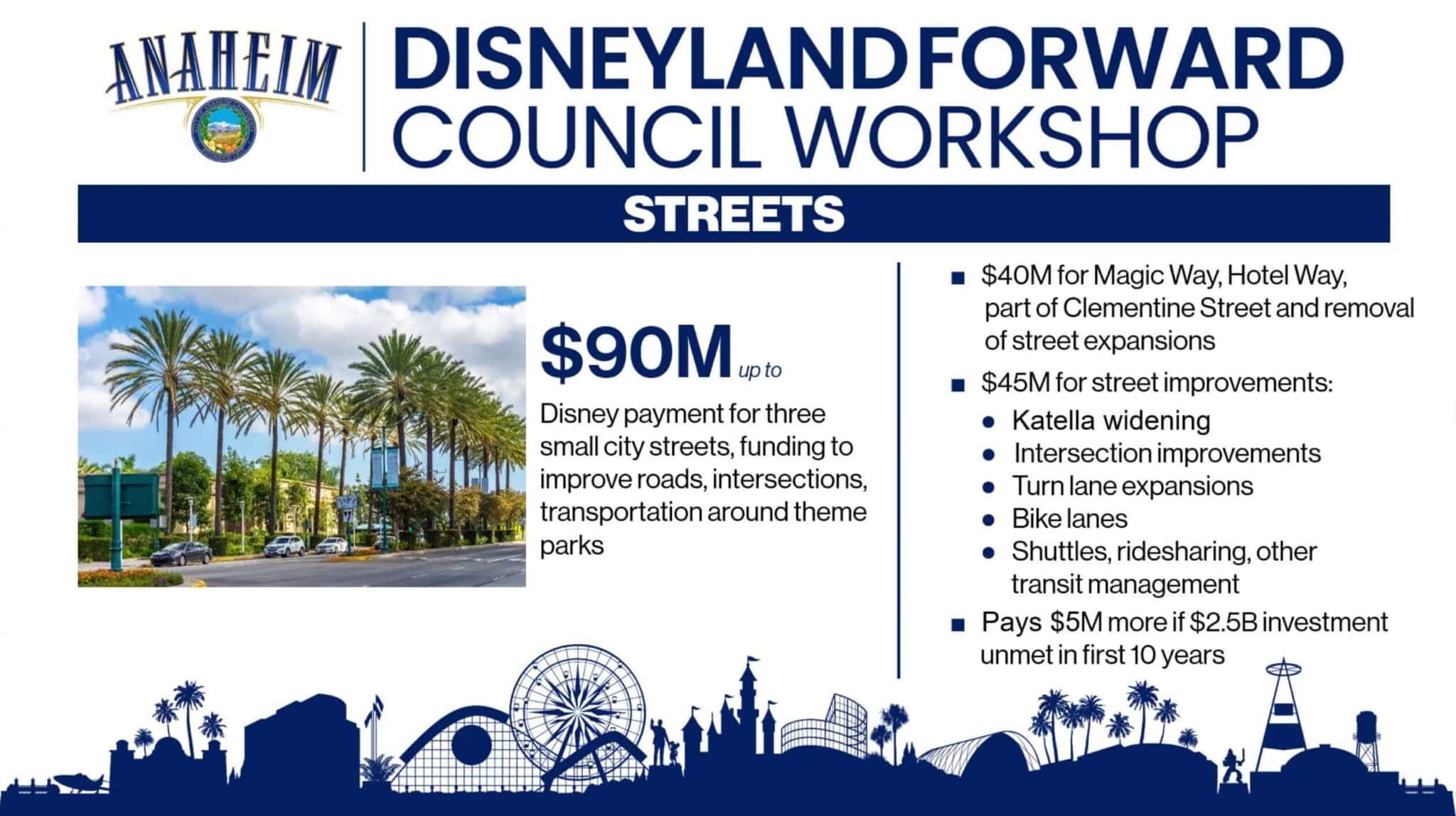

Disney would also offer a payment for city streets, funding of street, transportation improvements:
- Disney to pay $40 million market value for existing streets, including Magic Way (1,150 feet in length from Disneyland Drive to Walnut Street), Clementine Street (575 feet into Toy Story Parking Area), Hotel Way (125-foot entry drive to Disney’s Pumbaa Parking Lot)
- Extension removals: Clementine Street from Katella Avenue to Orangewood Avenue and Gene Autry Way from Haster Street to Harbor Boulevard
- About half of $40 million for Magic, Hotel and Clementine goes to Anaheim general fund, with Clementine, Gene Autry payment going to road upgrades
- Would be part of up to $90 million in Disney street and transportation funding, including Katella widening east and west of Harbor, improved intersections, signal upgrades, bike lanes and more
- Disney pays added $5 million for streets if it does not complete $2.5 billion in visitor investment, or $600 million more than minimum, within 10 years
It’s probably safe to say that if DisneylandForward is going to be a substantive thing down the road that results in even some of the teased developments, this all needs to happen. Streamlining traffic flow through Anaheim and into the resort area is a good thing, especially when combined with the next proposal.
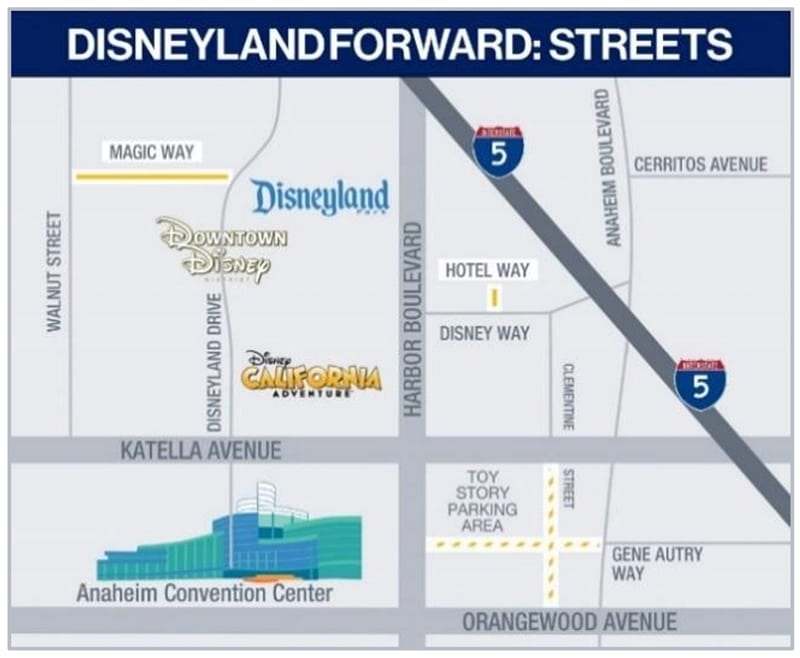

Disney commits to building a parking structure east of Harbor Boulevard and bridges over Harbor and Disneyland Drive as part of DisneylandForward:
- Proposed 17,000-space eastside parking structure serving northbound arrivals on the Santa Ana (I-5) Freeway with walking bridge to theme parks
- Eastside structure would add to existing 16,300 spaces at Mickey & Friends and Pixar Pals structures on Harbor westside serving southbound freeway arrivals
- Disney support for building up to three foot bridges over Harbor and up to two over Disneyland Drive
No huge surprise that Disney still wants the Eastern Gateway project, which was something similar to this that faced fierce opposition from local businesses and the City of Anaheim. The parking structure and expansion project was ultimately abandoned by Disney (along with a luxury hotel to replace part of Downtown Disney–the area now being built on with the lawn and Din Tai Fung), and Pixar Pals was built instead.
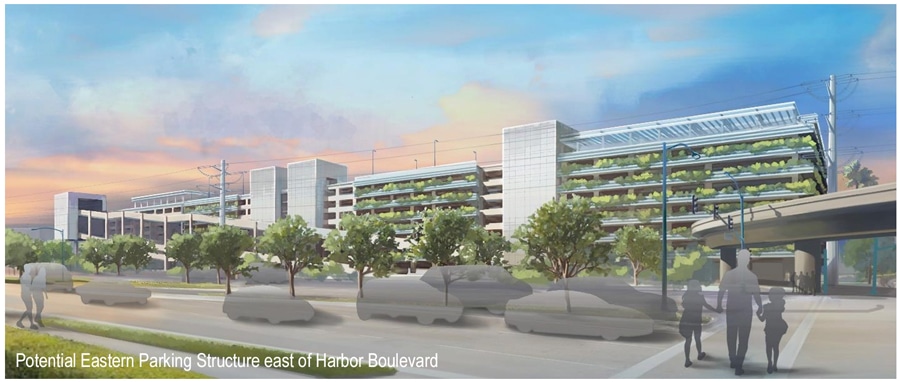

Disney clearly really wants this parking structure. You may not be inclined to care; after all, who is a fan of parking structures? I would advise rethinking that perspective. From my perspective, this is the strongest sign of all that Disney is serious about DisneylandForward. Now that they have Pixar Pals, they don’t need to build another parking structure based on current guest demand for parking.
The only way they need another parking structure is if they want to free up surface lots for attendance-driving expansion. So the Eastern Gateway proposal in a post-Pixar Pals environment signals both that Disneyland wants to free up space to build new things and that whatever they build is going to be a major driver of demand, necessitating more parking.
As someone who lives south of Disneyland and hates the Toy Story lot, I’m also biased towards this project for personal reasons. I’d hazard a guess that this could shave 10 minutes or more off our commute time, especially given that the walk would be shorter than the current one from Pixar Pals.
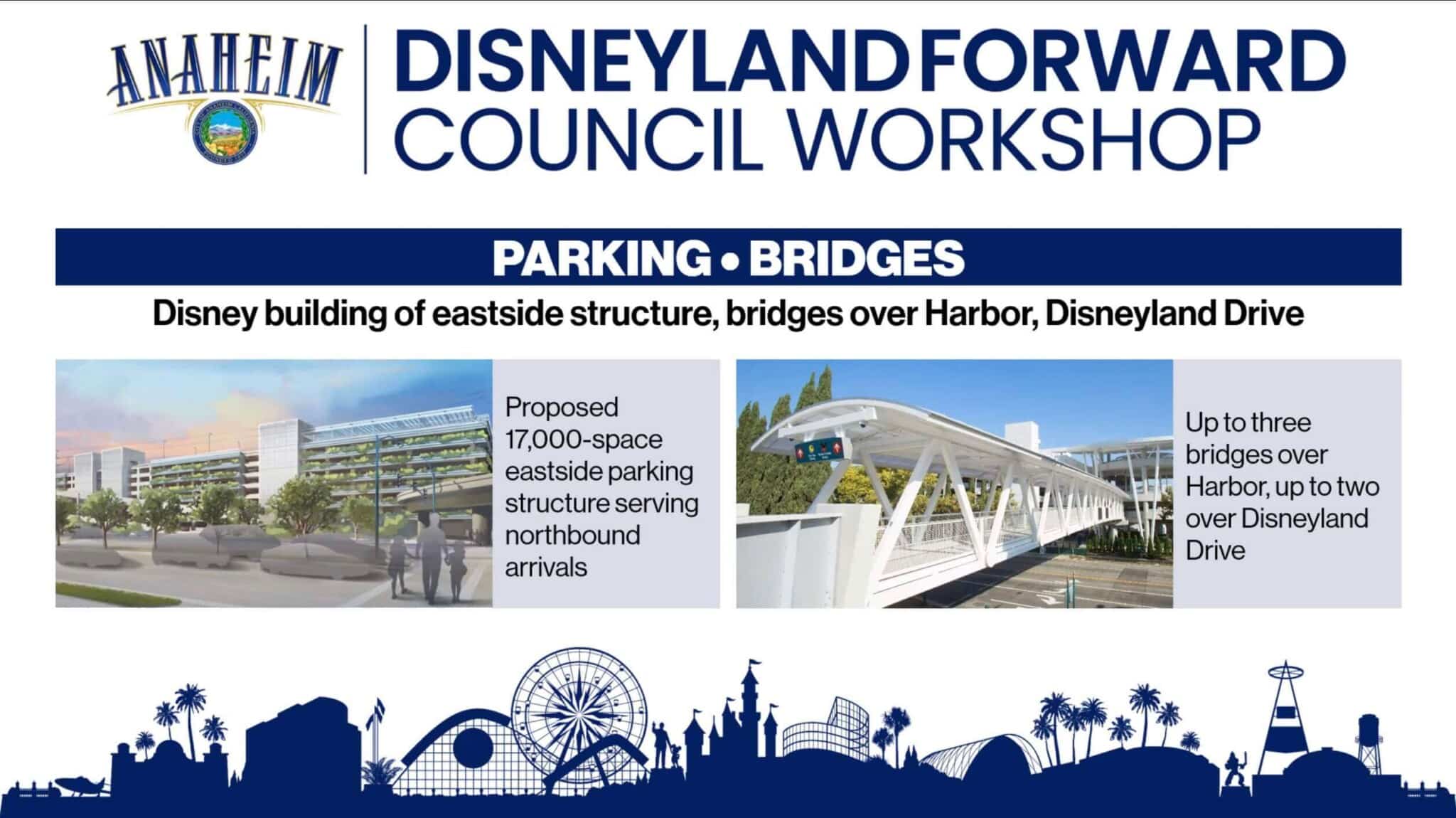

Finally, Disney would fund sewer expansion as part of DisneylandForward:
- Disney commits up to $10 million to expand sewer main line along Katella Avenue just to the south of theme parks
- Part of $15 million to $20 million sewer expansion along Katella and Anaheim Boulevard, with Disney paying for Katella and city paying for Anaheim Boulevard
- Expansion could be installation of larger pipes or a second set of pipes, pending design work for any potential project
After our groundbreaking work on the ‘top toilets’ series, I’m sure most of you view this site as the source for sewage discourse. But in reality, I have zero expertise on the matter–I’m simply an amateur bathroom buff. So I can’t really comment on this with any degree of authority. Given that it’s included in the proposal, I’m inclined to assume this is needed and was negotiated by Disney and Anaheim.
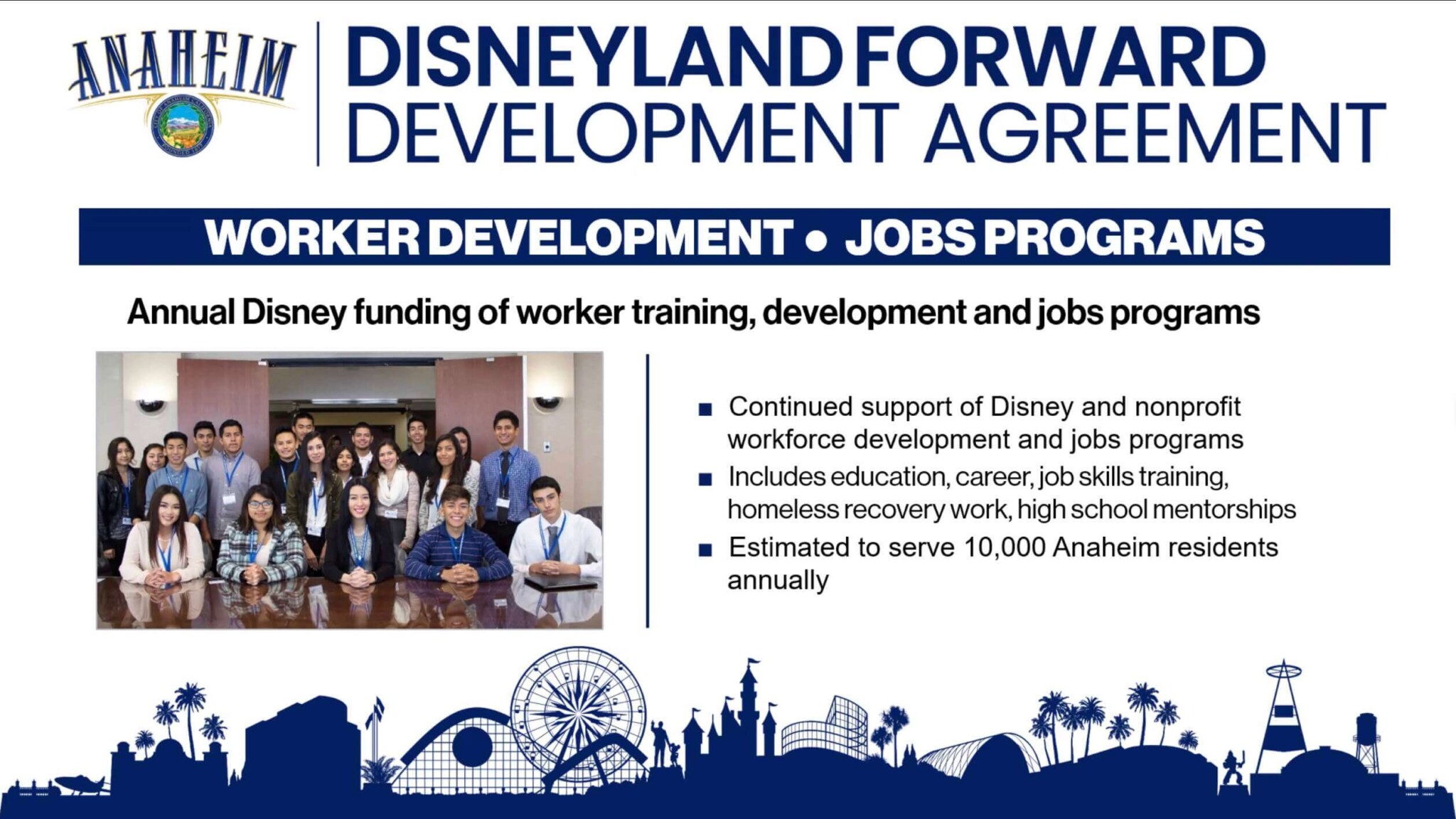

If you’re wondering what happens next, here’s the DisneylandForward Timeline:
- January 2024: City Council workshop with proposed development agreement overview
- February 2024: Planning Commission workshop, including development agreement overview
- March 2024: Planning Commission hearing on DisneylandForward
- April & May 2024: City Council hearings on DisneylandForward
For more on DisneylandForward, including the Development Proposal Fact Sheet and Resort Specific Plan, see this page on the City of Anaheim website.
Planning a Southern California vacation? For park admission deals, read Tips for Saving Money on Disneyland Tickets. Learn about on-site and off-site hotels in our Anaheim Hotel Reviews & Rankings. For where to eat, check out our Disneyland Restaurant Reviews. For unique ideas of things that’ll improve your trip, check out What to Pack for Disney. For comprehensive advice, consult our Disneyland Vacation Planning Guide. Finally, for guides beyond Disney, check out our Southern California Itineraries for day trips to Los Angeles, Laguna Beach, and many other SoCal cities!
YOUR THOUGHTS
What do you think about the DisneylandForward proposal? Excited and optimistic about this news, or still think Disney isn’t committing to enough in Anaheim? Any predictions as to whether Disney will be successful in gaining support for DisneylandForward? Do you agree or disagree with our assessment? Any questions we can help you answer? Hearing your feedback–even when you disagree with us–is both interesting to us and helpful to other readers, so please share your thoughts below in the comments!

